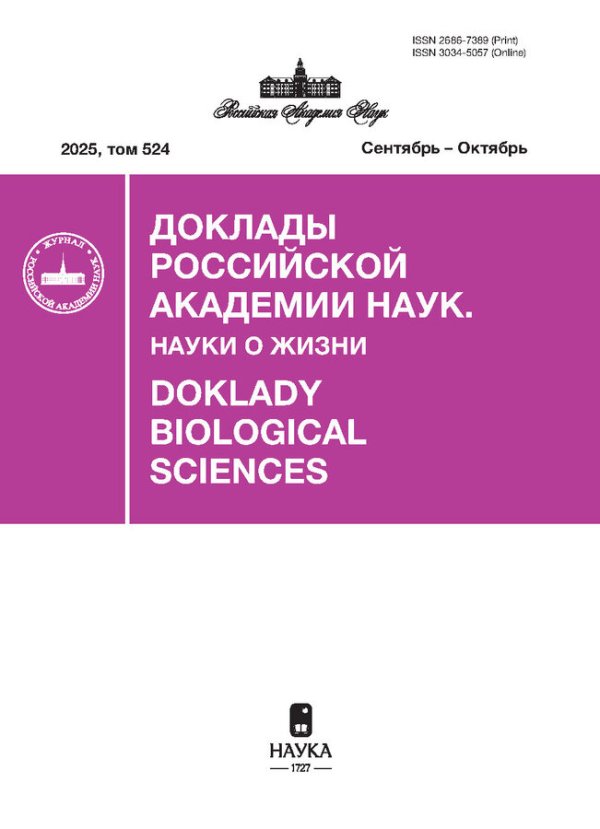Уровень экспрессии генов инициации цветения (CONZ1, GIGZ1A, GIGZ1B, FKF1A, FKF1B) в проростках в условиях длинного дня различает ранне- и позднеспелые линии Zea mays l.
- Авторы: Архестова Д.Х.1,2, Анисимова О.К.1, Кочиева Е.З.1, Щенникова А.В.1
-
Учреждения:
- Федеральное государственное учреждение «Федеральный исследовательский центр “Фундаментальные основы биотехнологии” Российской академии наук»
- Институт сельского хозяйства, филиал Кабардино-Балкарского научного центра Российской академии наук
- Выпуск: Том 513, № 1 (2023)
- Страницы: 544-548
- Раздел: Статьи
- URL: https://journals.rcsi.science/2686-7389/article/view/244363
- DOI: https://doi.org/10.31857/S2686738923700385
- EDN: https://elibrary.ru/XQDDEX
- ID: 244363
Цитировать
Полный текст
Аннотация
Охарактеризовано 20 инбредных линий кукурузы Zea mays L. по длительности фенофаз, включая сроки цветения и спелости. Исследована экспрессия ключевых генов инициации цветения, CONZ1, GIGZ1a, GIGZ1b, ZmFKF1a и ZmFKF1b, в проростках шести линий кукурузы, различающихся сроками спелости, в условиях длинного фотопериода. Выявлен существенно более низкий уровень транскриптов всех пяти генов у раннеспелых линий в сравнении с позднеспелыми образцами. Показана сходная экспрессия паралогичных генов GIGZ1a и GIGZ1b, а также значительное преобладание экспрессии ZmFKF1a в сопоставлении с паралогичным ему геном ZmFKF1b.
Ключевые слова
Об авторах
Д. Х. Архестова
Федеральное государственное учреждение «Федеральный исследовательский центр “Фундаментальные основы биотехнологии”Российской академии наук»; Институт сельского хозяйства, филиал Кабардино-Балкарского научного центра Российской академии наук
Email: shchennikova@yandex.ru
Россия, Москва; Россия, Нальчик
О. К. Анисимова
Федеральное государственное учреждение «Федеральный исследовательский центр “Фундаментальные основы биотехнологии”Российской академии наук»
Email: shchennikova@yandex.ru
Россия, Москва
Е. З. Кочиева
Федеральное государственное учреждение «Федеральный исследовательский центр “Фундаментальные основы биотехнологии”Российской академии наук»
Email: shchennikova@yandex.ru
Россия, Москва
А. В. Щенникова
Федеральное государственное учреждение «Федеральный исследовательский центр “Фундаментальные основы биотехнологии”Российской академии наук»
Автор, ответственный за переписку.
Email: shchennikova@yandex.ru
Россия, Москва
Список литературы
- Miller T.A., Muslin E.H., Dorweiler J.E. // Planta. 2008. V. 227 (6). P. 1377–1388.
- Liu L., Wu Y., Liao Z., et al. // Heredity (Edinb). 2018. V. 120 (4). P. 310–328.
- Sawa M., Nusinow D.A., Kay S.A., et al. // Science. 2007. V. 318. P. 261–265.
- Kami C., Lorrain S., Hornitschek P., et al. // Curr. Top. Dev. Biol. 2010. V. 91. P. 29–66.
- Mishra P., Panigrahi K.C. // Front. Plant Sci. 2015. V. 6. P. 8.
- Ronald J., McCarthy K., Davis S.J. // Mol. Plant. 2020. V. 13 (3). P. 357–359.
- Ke Q., Kim H.S., Wang Z., et al. // Plant Biotechnol. J. 2017. V. 15 (3). P. 331–343.
- Kim W.Y., Fujiwara S., Suh S.S., et al. // Nature. 2007. V. 449. P. 356–360.
- Matsuoka Y., Vigouroux Y., Goodman M.M., et al. // Proc. Natl. Acad. Sci. USA. 2002. V. 99 (9). P. 6080–6084.
- Chen Q., Zhong H., Fan X.W., et al. // Plant, Cell & Environment. 2015. V. 38 (8). P. 1479–1489.
- Bendix C., Mendoza J.M., Stanley D.N., et al. // Plant Cell Environ. 2013. V. 36 (7). P. 1379–1390.
- Li Z., Gao F., Liu Y., et al. // Plant Sci. 2023. V. 332. P. 111701.
- Rubio V., Deng X.W. // Science. 2007. V. 318 (5848). P. 206–207.
Дополнительные файлы











